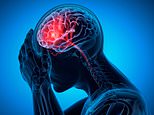Headaches are a common ailment and usually there is nothing to worry about.
But in some cases, they are the first sign of a deadly disease, such as a brain hemorrhage or even a cancerous tumor.
Now, an American doctor has taken to Instagram to advise how to differentiate between a sinister headache and a harmless one.
Neurologist Dr. Baibing Chen He said two specific symptoms are a telltale red flag.
“If a headache suddenly feels different, like a thunderclap headache, or if it lasts longer (than usual), it could be due to something serious like a hemorrhage, tumor or aneurysm,” he said.
Thunderclap headaches, named after a weather phenomenon, are sudden, agonizing pains that feel similar to a blow to the head, resulting in “blinding pain like never before experienced,” according to the NHS.
This is considered a medical emergency and the health service advises those affected to call 999 or go to A&E.
A sudden, thunderous headache can be a sign of a ruptured blood vessel in the brain, which can lead to lifelong disability, coma, and even death.
Headaches can also be a sign of a brain tumor, so doctors often recommend visiting your GP if headaches become new or more frequent.
In addition to revealing warning signs of brain disorders, Dr. Chen offered his social media followers ways to prevent neurological conditions, including the terrifying “locked-in syndrome.”
This happens when the brain stem is severely damaged, causing paralysis of voluntary muscles, except those that control vertical eye movements (up and down).
Those with the disorder are conscious and have normal cognitive abilities, but cannot speak or move.
Dr. Chen said neck manipulation, a technique performed by some chiropractors, could put patients at risk of developing this life-destroying disease.
Treatment involves manually manipulating the bones in the upper spine to relieve neck pain.
Dr. Chen said he would never undergo such a technique because of the serious, though small, risk of something going terribly wrong.
“Forced neck adjustments can carry a rare but serious risk, and that is vertebral artery dissection,” he said.
This is a tear in one of the arteries in the neck that supplies oxygen-rich blood to the brain stem. Such an injury carries the risk of causing a stroke.
Dr. Chen continued, “A brainstem stroke can cause one of the scariest things I’ve ever seen, and it’s called ‘locked-in syndrome,’ where you’re fully conscious but can’t move or talk.”
Last on the doctor’s “never” list was missing out on regular, good-quality sleep.
“Chronic sleep deprivation can increase the risk of dementia and cause a number of neurological problems,” he said.
“So, even with a busy schedule in the hospital and coming home to two young children, I try my best to get a good night’s sleep and get at least six hours of sleep when I can.”
The NHS reports that most adults need between seven and nine hours of good quality sleep a day.

